|
FIRE SUPPORT COORDINATING
MEASURES |
| This appendix implements STANAG 2099/QSTAG 531, Edition 4. |
The FSCOORD coordinates all fire support impacting in the area of responsibility of his supported maneuver commander, including that requested by the supported unit. He ensures that fire support will not jeopardize troop safety, will interface with other fire support means, and/or will not disrupt adjacent unit operations. Fire support coordinating measures help him in those efforts. They are designed to facilitate the rapid engagement of targets and, at the same time, provide safeguards for friendly forces.
Some fire support coordinating
measures described here have not yet been agreed to by NATO and
American British, Canadian and Australian (ABCA) allies. The US
terms "coordinated fire line, restrictive fire line, restrictive
fire area," and "fire coordination line" are being
proposed by the US for inclusion in STANAG 2099/QSTAG
531. The
fire support coordination line and the optional use of the no-fire
line (NFL) are the only measures agreed to in STANAG 2099/QSTAG
531. The US has entered a reservation using coordinated fire line
in lieu of no-fire line.
All fire support coordinating
measures except boundaries are established by the supported maneuver
commander on the basis of recommendations by the FSCOORD. The
FSCOORD's recommendation are based on the force commander's guidance,
location of friendly forces, the battle plan, and anticipated
enemy actions.
Once established, coordinating
measures are displayed on maps, firing charts, and overlays and
are stored in computers. Graphic portrayal includes, as a minimum,
the visual code, the abbreviation for the measure, the establishing
headquarters, and the effective date-time group (DTG). Often,
the date-time group is shown as a from-to time. Usually, coordinating
measures are labeled at each end of a line or within the graphic,
space permitting. Both the graphics and the lettering are in black
for all measures.
In various operations, boundaries
are used by the maneuver commander to indicate the geographical
area for which a particular unit is responsible. They describe
a zone of action or sector of responsibility for a maneuver unit.
Normally, they are designated along terrain features easily recognizable
on the ground. They are so situated that key terrain features
and avenues of advance or approach are completely included in
the area assigned to one unit. A boundary is the basic fire support
coordinating measure. Boundaries are both permissive and restrictive
in nature. They are restrictive in that no fire support means
may deliver fires across a boundary unless the fires are coordinated
with the force having responsibility within the boundary or unless
a permissive fire support coordinating measure is in effect that
would allow firing without further coordination. Fires delivered
near boundaries also should be coordinated with the adjacent unit.
They are permissive in that a maneuver commander, unless otherwise
restricted, enjoys complete freedom of fire and maneuver within
his own boundaries. Boundaries apply to both the maneuver of units
and the employment of fire, to include conventional and special
ammunition and their effects. Boundaries are displayed as solid
black lines with the appropriate designation of the unit(s) to
which the boundary applies. Proposed or planned boundaries are
displayed as dashed black lines. Boundaries are also used by fire
support personnel to designate the zone of fire for supporting
field artillery and naval gunfire ships.
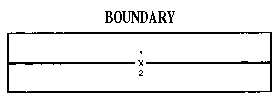
Zones of fire are assigned
to FA and NGF units for the control of fires laterally and in
depth to support operations. Lateral limits within which a unit
must be able to fire may be designated by azimuths or boundaries.
Zones in depth may be designated by minimum or maximum range lines
or by forward or rearward extensions of the lateral boundaries
of the supported force. The zone of fire for an artillery unit
is dictated by the assigned tactical mission. For example, the
direct support mission specifies that the zone of fire is the
zone of action of the supported maneuver force. Uniform coverage
is not a requirement, since the maneuver commander may want to
weight certain portions of his zone of action with a fire support
means such as artillery.
With the exception of boundaries,
fire support coordinating measures are either permissive or restrictive.
In essence, the primary purpose of a permissive measure is to
facilitate the attack of targets. The establishment of a restrictive
measure imposes certain requirements for specific coordination
before the engagement of those targets affected by the measure.
Therefore, the primary purpose of a restrictive measure is to
safeguard friendly forces.
A coordinated fire line is
a line beyond which conventional or improved conventional indirect-fire
means (mortars, field artillery, and NGF ships) may fire at any
time within the zone of the establishing headquarters without
additional coordination. The purpose of the CFL is to expedite
the attack of targets beyond it. Usually, the CFL is established
by a brigade or a division, but it may be established by a maneuver
battalion. It is located as close to the establishing unit as
is possible, without interfering with maneuver forces, to open
up the area beyond to fire support. Brigade CFLs may be consolidated
at division level as a division CFL designated for the division
zone of action. If any modifications to the brigade CFLs are considered,
they must be coordinated with the brigades to ensure complete
compatibility with their battle plans. In essence, the brigade
commanders establish CFLs, and the division commander merely consolidates
them and designates a division coordinated fire line.
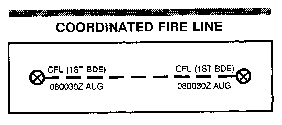
An FSCL may be established
by the corps within its area of operation to support its concept
of the operation. It must be coordinated with the appropriate
tactical air commander and other supporting elements. The purpose
of this permissive fire control measure is to allow the corps
and its subordinate and supporting units (such as the Air Force)
to expeditiously attack targets of opportunity beyond the FSCL.
The attack of targets beyond the FSCL by Army assets should be
coordinated with supporting tactical air. This coordination is
defined as informing and/or consulting with the supporting tactical
air component. However, the inability to effect this coordination
does not preclude the attack of targets beyond the FSCL. The interface
within the FS cell between the various fire support representatives
provides an excellent means of initially coordinating the attack
of targets in this area. Targets of opportunity beyond the FSCL
are attacked by a unit if such attacks support the operations
of any one of the following:
-
The attacking unit.
-
The higher headquarters of
that unit.
-
A headquarters supported by
that unit.
-
A portion of the corps deep
operations area does not require selective targeting to shape
the deep operations fight.
-
The expeditious attack of
targets beyond the FSCL will support the operations of the corps,
the attacking unit, or the higher head-quarters of the attacking
unit.
-
The corps and its supporting
units are willing to accept the possible duplication of effort
which may result from dual targeting beyond the FSCL.
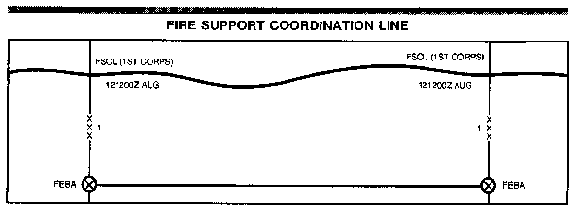
However, the corps deep operations concept may not seek to shape the fight but only focus on maximizing the destruction of enemy units and/or systems. Then the corps should establish the FSCL as close as possible to its close operations area. This maximizes the number of fire support systems capable of firing beyond the FSCL. A restrictive fire area or a no-fire area can be used to protect key facilities or terrain features beyond the FSCL. This would still allow for an FSCL short of the facility or terrain feature which must be protected.
Whether attacking or defending,
the corps usually designates an initial FSCL and plans for a series
of on-order FSCLs. A change of FSCL location usually is transmitted
well ahead of time to higher, lower, adjacent, and supporting
headquarters.
Dissemination of the FSCL
is the same as that for the coordinated fire line.
| NOTE: The
above information is in compliance with the provisions of STANAG 2099/QSTAG
531. However, FM 100-26 states "Areas on the battlefield
should never be considered the absolute province of either USA
or USAF commanders. Both component commanders will have a continuing
interest in the enemy regardless of depth. They will want to collect
Intelligence and attack- or cause to be attacked - targets that
will affect their future operations. The planning to attack targets
in the second echelon should be coordinated among components,
concurrence sought, and if not obtained, the matter should be
referred to the next higher headquarters." |
FSCL employment considerations
are as follows:
-
Type of operation - offensive
or defensive, and so forth.
-
Deep operations with maneuver.
-
Nature and location of Threat.
-
Target acquisition capabilities.
-
Allocations of air support.
-
Future operations.
A free-fire area (FFA) is
a specific area into which any weapon system may fire without
additional coordination with the establishing headquarters. It
is used to expedite fires and to facilitate the jettison of munitions
when aircraft are unable to drop them on a target area. Usually,
the FFA is established by a division or higher commander. It is
located on identifiable terrain when possible or by grid designation
when necessary. It is disseminated through both maneuver and fire
support channels.
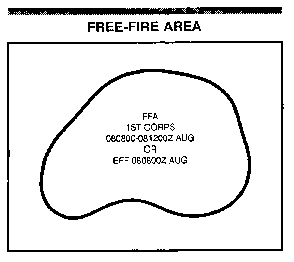
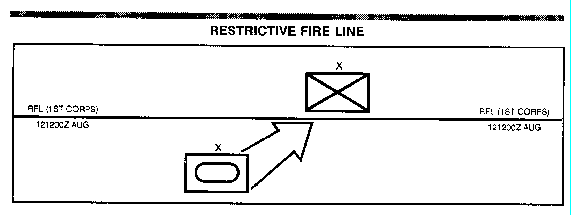
This is a line established
between converging friendly forces (one or both may be moving)
that prohibits fires or the effects of fires across the line without
coordination with the affected force. The purpose of the line
is to prevent interference between the converging friendly forces.
It is established by the commander common to the converging forces.
It is located on identifiable terrain, usually closer to the stationary
force. Its location is disseminated in the same manner as that
of a coordinated fire line.
The ACA is primarily a coordination
effort of TACAIR and indirect fires; therefore, fire support people
are the focal planning point.
The ACA is a block of airspace
in the target area in which friendly aircraft are reasonable safe
from surface fires. Occasionally, it may be a formal measure (a
three-dimensional box in the sky). More often, it is informal.
The purpose of the ACA is to allow the simultaneous attack of
targets near each other by multiple fire support means, one of
which normally is air. For example, tactical aircraft, field artillery,
and naval gunfire can attack the same target complex or targets
close to one another while operating within the parameters of
an established ACA.
Implementation of the formal
ACA takes a significant amount of time. Therefore, informal ACAs
are most often used and are the preferred method. The informal
ACA can be established by using time, lateral separation, or altitude
to provide separation between surface-to-surface and air-delivered
fires. An example would be to designate a road as the lateral
separation feature and direct air support to stay north of the
road and restrict FA and naval gunfire to airspace and targets
south of the road. The informal ACA can be established at task
force or higher level and is not normally displayed on maps, charts,
or overlays.
Occasionally, there may be
a requirement for a separate brigade or higher-level commander
to establish a formal ACA. Its location is coordinated by the
FS cell with the A2C2 element and the FDC.
It is located above the target area as recommended to the FS cell
by the air liaison element. The size of the area is dictated by
the type of aircraft and the ordnance in use.
Vital information defining
the formal ACA includes minimum and maximum altitudes (alt), a
baseline designated by grid coordinates at each end, the width
(either side of the baseline), and the effective times. Information
concerning the area is disseminated in the same way that it is
for the coordinated fire line.
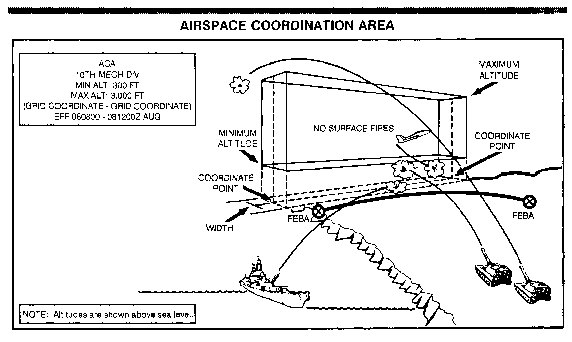
An NFA is an area into which
no fires or effects of fires are allowed. Two exceptions are--
-
When establishing headquarters
approves fires temporarily within the NFA on a mission-by-mission
basis.
-
When an enemy force within
the NFA engages a friendly force. The commander may engage the
enemy to defend his force.
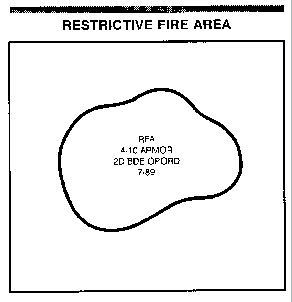
An RFA is an area in which
specific restrictions are imposed and in which fires that exceed
those restrictions will not be delivered without coordination
with the establishing headquarters. The purpose of the RFA is
to regulate fires into an area according to the stated restrictions.
It is established by maneuver battalion or higher echelons of
command. On occasion, an RFA may be established by a company operating
independently. Usually, it is located on identifiable terrain,
by a grid or by radius (in meters) from a center point. Its location
is disseminated in the same manner as that of the coordinated
fire line. Restrictions may be shown on a map or an overlay, or
reference can be made to an OPORD that states the restrictions.
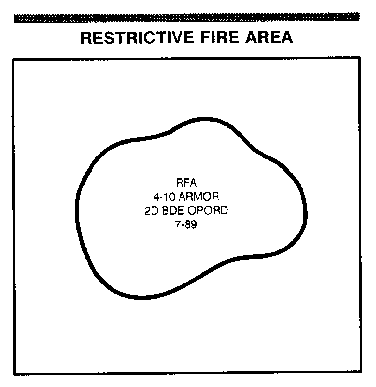
|
NEWSLETTER
|
| Join the GlobalSecurity.org mailing list |
|
|
|

